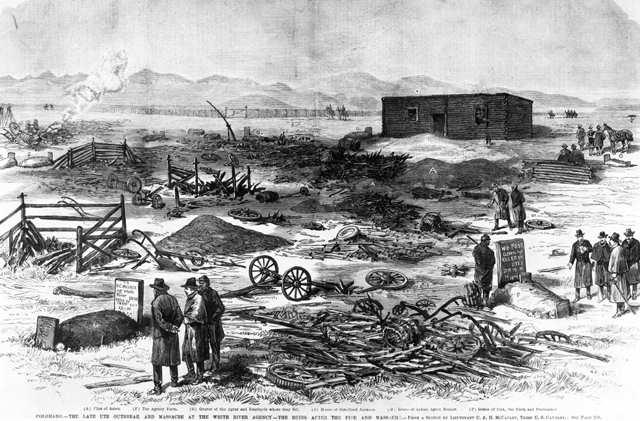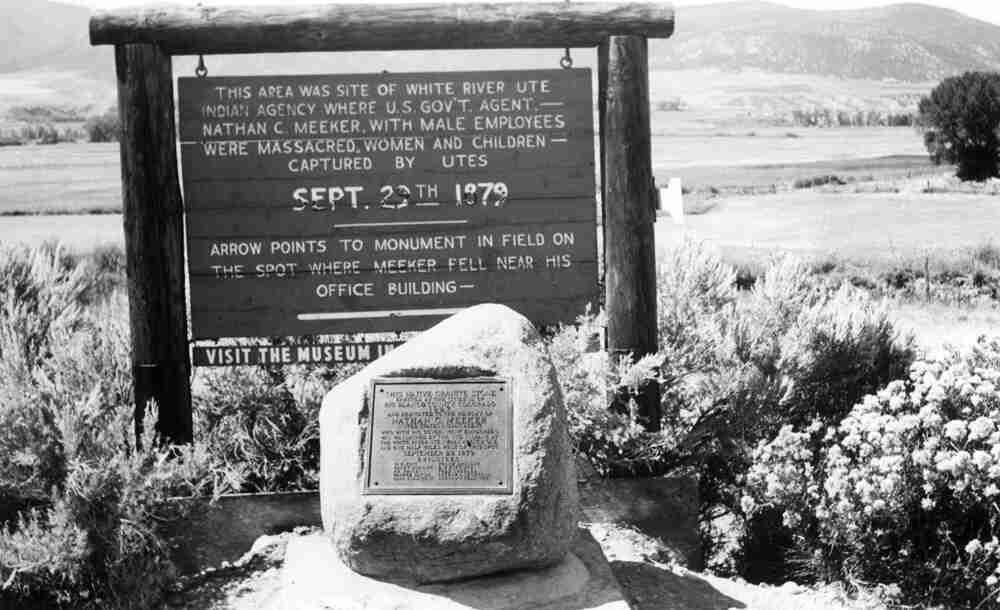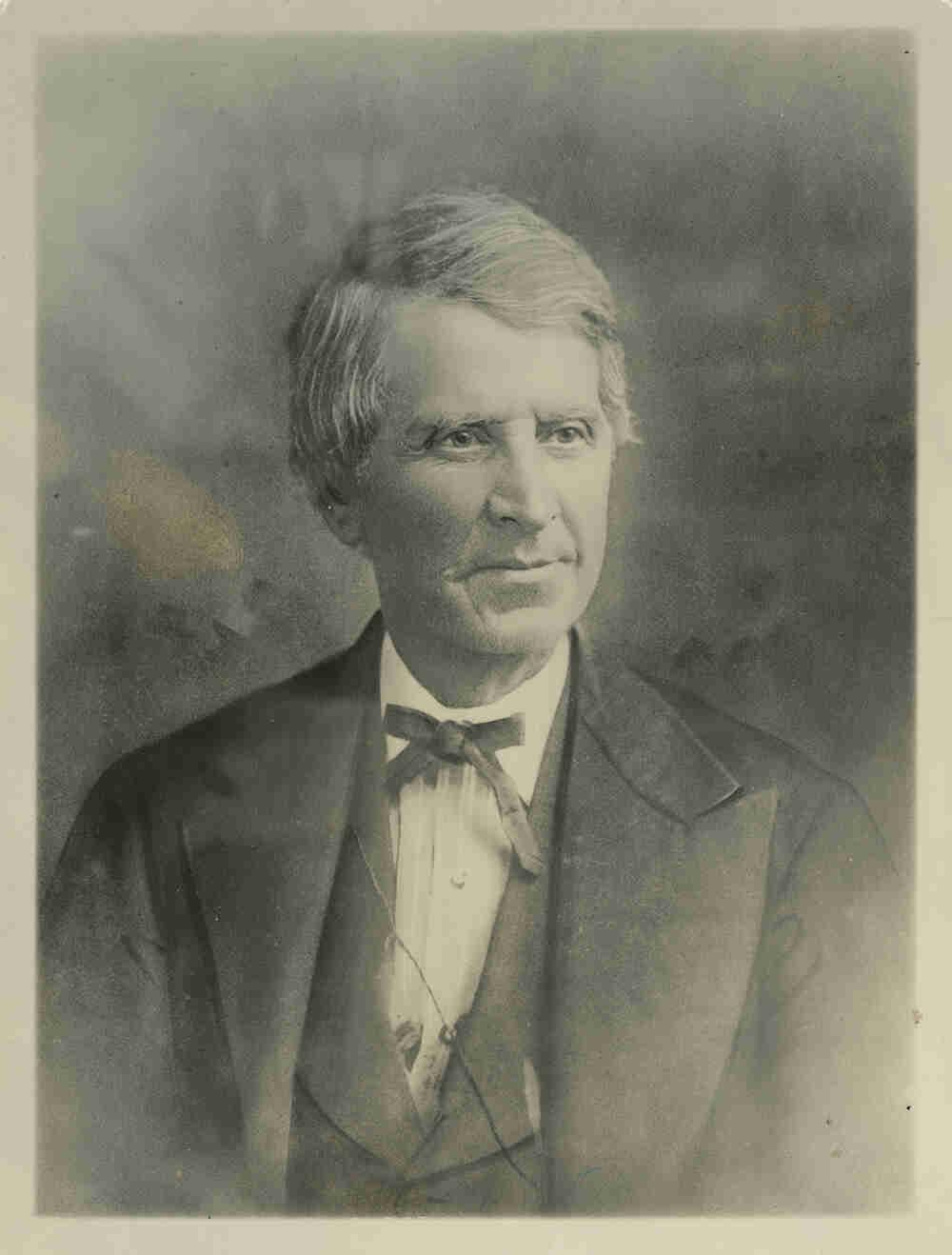Meeker
Full Article
About 225 miles west of Denver, at an elevation of 6,400 feet and adjacent to the White River, lies the small mountain community of Meeker. It is known for its ranching and access to hunting and fishing areas, as well as other outdoor recreation hotspots, including the nearby Flat Tops. With a permanent population of approximately 2,500, Meeker is not a large town. However, the community’s history played a critical role in the removal of the majority of Ute Indians from Colorado and the opening of the western third of the state to white settlement.
Nathan Meeker and Ute Removal
Broad, grassy meadows near what is now the town of Meeker provided the Ute Indians with ideal grazing lands for their large horse herds. That fact, coupled with the determination of Indian Agent Nathan C. Meeker to alter the Utes’ traditional horse culture, would play a critical role in the events of 1879 that led to the deaths of Meeker and others, the removal of most Utes from Colorado, and the creation of the town of Meeker.
Nathan Meeker was appointed agent for the White River Indian Agency in 1878. At the time, the agency was one of three that served an estimated 4,000 Ute Indians on the 12-million-acre Ute Indian Reservation that covered much of Colorado’s Western Slope.
Meeker’s patronizing attitude toward the Utes, and his insistence that they get rid of most of their horses and abandon their hunting lifestyle in favor of farming, caused increasing tension between the agent and the Native Americans. The conflict came to a head in September 1879 after Meeker ordered his employees to plow up a field the Utes used for horse racing. He and a Ute leader named Canalla (Johnson) got into a pushing match, and Meeker sent messages to state and federal officials pleading for US Army intervention.
Army support arrived on the morning of September 29, 1879, and approximately 140 cavalry troops entered the Ute Reservation. Soon, shots were fired and the week-long Battle of Milk Creek began. Thirteen whites and at least nineteen Utes were killed during the battle.
Although it is not clear which side fired the first shots, there is no doubt that the Utes viewed the army’s incursion onto their reservation as a violation of treaty terms, even an invasion. Several days before the battle began, Ute leaders such as Nicaagat and Colorow had pleaded with Major Thomas Thornburgh not to bring his entire force onto the reservation but instead to bring only a half-dozen men to the White River Indian Agency to discuss problems between Meeker and the Utes. Thornburgh at first agreed, but later, after the Indians had left, he decided to go to the agency with his entire force.
Once the first shots had been fired, his fellow Utes ignored Nicaagat’s urging to hold their fire. He was unable to halt young Ute warriors from engaging in battle with the soldiers.
Most of the shooting and fatalities occurred during the first hours of the battle. But the Utes, holding ground on the ridges surrounding Milk Creek, had the army troops pinned down in a low spot in the valley. They kept them trapped there until army reinforcements arrived from Cheyenne, Wyoming, a week later.
The same day the Milk Creek battle began, another fight occurred about twenty miles to the southwest at the White River Indian Agency. Nathan Meeker and his eight male employees were killed. Meeker’s wife and daughter were taken hostage, along with the wife of an agency employee and her two small children. They were held for twenty-three days before being released.
The Battle of Milk Creek, the killings of the agency employees, and the taking of hostages sparked nationwide outrage and quick political action. By June 1880, the US Congress had passed legislation to require the White River Utes and the Uncompahgre Utes to abandon their traditional homelands and move to much smaller and less verdant reservations in Utah. They were forcibly removed the following year. Two Ute bands in southwestern Colorado, which became known as the Southern Utes and the Ute Mountain Utes, were allowed to remain in Colorado on much smaller reservations.
In 1879 the US Army constructed buildings to house troops along the White River a few miles upstream from the Indian agency. Those buildings soon became the nucleus of the budding town of Meeker, which was incorporated in 1885.
Ranching and Tourism in Meeker
Ranching prospered in the decades following the removal of the Utes. Cattle and sheep are still raised in large numbers in the region around Meeker. Rio Blanco County, of which Meeker is the county seat, remains one of the top three sheep-raising counties in Colorado. That ranching heritage is celebrated each year with events such as the Meeker Range Call and the Meeker Sheepdog Trials. In addition, locals and part-time residents have found, as the Utes did long ago, that the White River Valley is an ideal place to raise and ride horses.
Outdoor recreation, especially hunting and fishing, soon became an important part of the regional economy. Theodore Roosevelt visited in January 1901, shortly before he was sworn in as vice president, to hunt mountain lion. Countless other hunters would follow over the years, attracted by the region's large deer and elk herds. It is said that Meeker’s population more than doubles during big-game hunting seasons.
But new ideas about preservation were also developing, and the fledgling wilderness movement can be traced in part to the Meeker area. In 1919 Arthur Carhart, a young recreation engineer with the US Forest Service, was sent to Trappers Lake on the Flat Tops east of Meeker to draw up a plan for putting houses and cabins around the lake. Instead, he forged an idea to preserve the lake in a natural state. That same year he met with another budding conservationist and Forest Service employee, Aldo Leopold, and they began communicating about ideas to protect more lands. When the Wilderness Act was passed in 1964, the Flat Tops Wilderness Area, including Trappers Lake, would be among the first wilderness areas officially recognized by Congress.
Development of Oil and Gas Industries
Meeker and the surrounding region have also seen the highs and lows of energy development. The town sits about fifty-five miles east of the Rangely oil field, also in Rio Blanco County, which began to produce oil in earnest during World War II. For many years, it was the largest-producing oil field in Colorado.
Meeker also sits near the heart of Colorado’s oil shale reserves. At one time in the early 1980s, energy operators and boosters projected that the small town would become a city of more than 20,000 residents. That did not occur, but in the first decade of the twenty-first century, Meeker again saw an energy boom from natural gas production. Drilling crews arrived in large numbers, but when natural gas prices began to fall in 2007, the boom slowed. Even so, large deposits of natural gas are still leased on federal and private lands near Meeker.
Meeker Reconnects with Its Roots
Meeker has also begun to give more recognition to those who inhabited the area long ago. In 2008 the community and the Forest Service held the first Smoking River Pow Wow in the town, formally inviting descendants of the original Utes back to the area. The Rio Blanco Historical Society has encouraged Ute involvement and recognition at its Milk Creek Battle memorial park and monument.





















